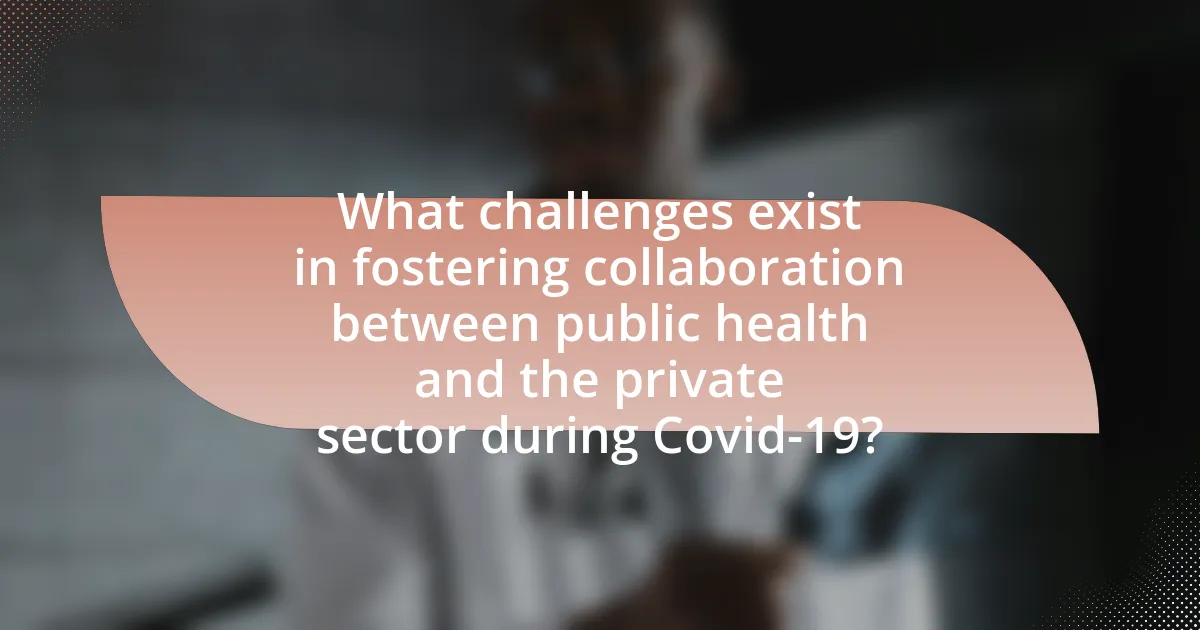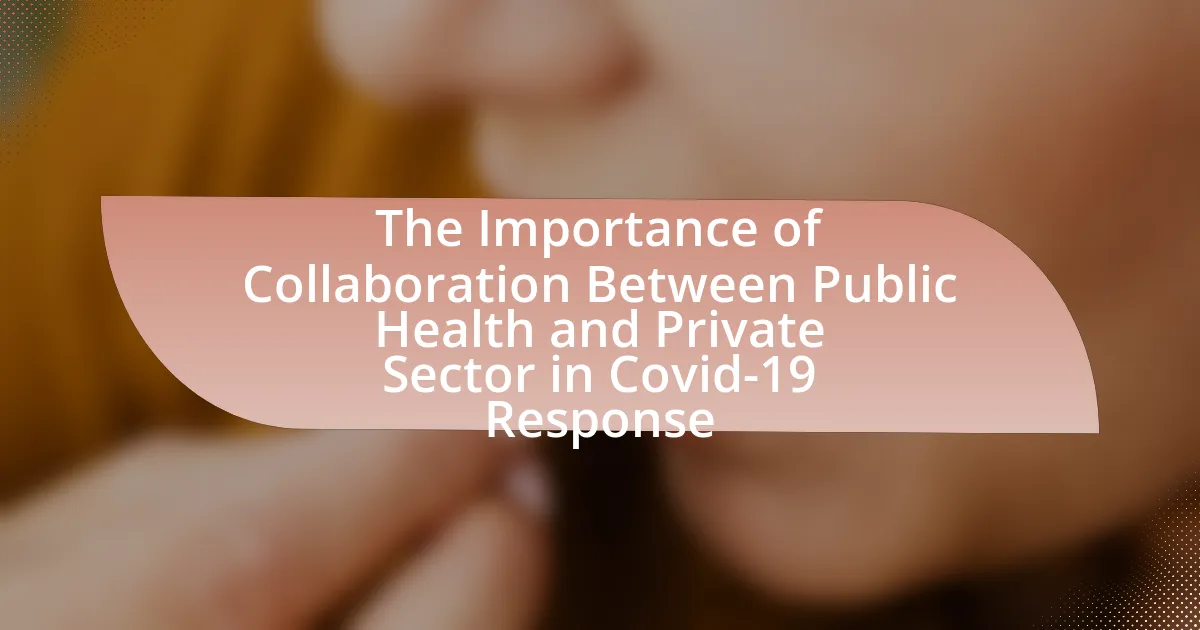The article focuses on the critical importance of collaboration between public health organizations and the private sector in responding to the Covid-19 pandemic. It highlights how such partnerships enhance resource mobilization, accelerate innovation, and improve public health outcomes, exemplified by the rapid development and distribution of vaccines like those created by Pfizer and BioNTech. The article further explores the roles of both sectors in facilitating effective communication, resource allocation, and compliance, while addressing the challenges and barriers that can hinder collaboration. Additionally, it discusses the economic benefits of these partnerships and outlines best practices for sustaining collaboration beyond the pandemic.

What is the importance of collaboration between public health and the private sector in the Covid-19 response?
Collaboration between public health and the private sector is crucial in the Covid-19 response as it enhances resource mobilization, accelerates innovation, and improves public health outcomes. This partnership allows for the rapid development and distribution of vaccines, exemplified by the collaboration between Pfizer and BioNTech, which led to the swift creation of an effective Covid-19 vaccine within months. Additionally, private sector involvement in testing and contact tracing has significantly increased capacity and efficiency, as seen in the deployment of rapid testing kits by companies like Abbott Laboratories. Such collaborations not only leverage the strengths of both sectors but also ensure a more coordinated and effective response to public health crises.
How does collaboration enhance the effectiveness of Covid-19 response efforts?
Collaboration enhances the effectiveness of Covid-19 response efforts by facilitating resource sharing, improving communication, and enabling rapid innovation. When public health agencies and private sector organizations work together, they can pool financial, technological, and human resources, which leads to more efficient vaccine development and distribution. For instance, the partnership between Pfizer and BioNTech resulted in the rapid development of one of the first Covid-19 vaccines, demonstrating how collaboration can accelerate scientific progress. Additionally, joint efforts in data sharing between governments and tech companies have improved contact tracing and public health messaging, leading to better-informed communities and more effective containment strategies.
What roles do public health organizations play in the collaboration?
Public health organizations play a crucial role in facilitating collaboration between various stakeholders during health crises, such as the COVID-19 pandemic. They serve as coordinators, bringing together government agencies, private sector entities, and community organizations to ensure a unified response. For instance, during the COVID-19 response, public health organizations provided essential data and guidelines that informed private sector actions, such as vaccine distribution and workplace safety protocols. Their involvement is supported by the fact that effective collaboration can lead to improved health outcomes, as evidenced by the rapid development and deployment of vaccines through partnerships between public health entities and pharmaceutical companies.
What roles do private sector entities play in the collaboration?
Private sector entities play critical roles in collaboration during the COVID-19 response by providing resources, expertise, and innovation. They contribute financial investments, which are essential for research and development of vaccines and treatments, as evidenced by companies like Pfizer and Moderna, which rapidly developed effective vaccines through partnerships with public health organizations. Additionally, private sector entities enhance supply chain logistics, ensuring timely distribution of medical supplies and vaccines, as demonstrated by logistics firms that facilitated the global distribution of COVID-19 vaccines. Furthermore, they leverage technology and data analytics to improve public health responses, exemplified by tech companies that developed contact tracing applications to help manage the spread of the virus.
Why is collaboration essential during a pandemic like Covid-19?
Collaboration is essential during a pandemic like Covid-19 because it enables a coordinated response that maximizes resources and expertise. Public health agencies and private sector organizations can share critical data, develop effective strategies, and implement solutions more efficiently when they work together. For instance, the collaboration between pharmaceutical companies and government entities led to the rapid development and distribution of vaccines, which was crucial in controlling the spread of the virus. According to a report by the World Health Organization, effective collaboration can significantly reduce response times and improve health outcomes during health emergencies.
How does collaboration improve resource allocation and management?
Collaboration improves resource allocation and management by enabling diverse stakeholders to share information, expertise, and resources effectively. This collective approach allows for a more accurate assessment of needs and priorities, leading to optimized distribution of resources. For instance, during the COVID-19 pandemic, partnerships between public health agencies and private sector organizations facilitated the rapid deployment of testing and vaccination resources, ensuring that areas with the highest need received adequate supplies. Research from the World Health Organization highlights that coordinated efforts can reduce duplication of services and enhance the overall efficiency of resource use, ultimately leading to better health outcomes.
What impact does collaboration have on public trust and compliance?
Collaboration significantly enhances public trust and compliance during health crises. When public health agencies and private sectors work together, they can provide transparent communication, share resources, and implement effective strategies, which fosters a sense of reliability among the public. For instance, during the COVID-19 pandemic, partnerships between government entities and private companies led to the rapid development and distribution of vaccines, which increased public confidence in health measures. Research by the World Health Organization indicates that effective collaboration can lead to higher compliance rates with health guidelines, as communities are more likely to trust and follow recommendations from entities they perceive as cooperative and transparent.

What are the key benefits of collaboration between public health and the private sector in Covid-19 response?
Collaboration between public health and the private sector in the Covid-19 response leads to enhanced resource mobilization, improved innovation, and more effective communication strategies. This partnership allows for the pooling of financial resources and expertise, which accelerates vaccine development and distribution; for instance, the collaboration between Pfizer and BioNTech resulted in the rapid development of one of the first Covid-19 vaccines, demonstrating the effectiveness of such alliances. Additionally, private sector involvement in data analytics and technology has improved contact tracing and public health messaging, ultimately leading to better pandemic management and response outcomes.
How does collaboration lead to innovation in health solutions?
Collaboration leads to innovation in health solutions by combining diverse expertise and resources from various stakeholders, including public health agencies and private sector organizations. This synergy fosters creative problem-solving and accelerates the development of effective health interventions. For instance, during the COVID-19 pandemic, partnerships between pharmaceutical companies and government entities resulted in the rapid development and distribution of vaccines, exemplified by the collaboration between Pfizer and BioNTech, which produced a vaccine in record time. Such collaborations leverage shared knowledge, enhance research capabilities, and streamline regulatory processes, ultimately driving advancements in health solutions.
What examples of innovative solutions emerged from public-private partnerships during Covid-19?
Innovative solutions that emerged from public-private partnerships during Covid-19 include the rapid development and distribution of vaccines, such as the collaboration between Pfizer and BioNTech, which resulted in the first mRNA vaccine authorized for emergency use in December 2020. This partnership leveraged Pfizer’s manufacturing capabilities and BioNTech’s innovative technology, leading to the production of over 2 billion doses by the end of 2021. Additionally, the collaboration between the U.S. government and private companies through Operation Warp Speed facilitated the accelerated development of multiple vaccines and therapeutics, significantly reducing the typical vaccine development timeline from years to months. These examples demonstrate how public-private partnerships effectively mobilized resources and expertise to address the urgent health crisis posed by the pandemic.
How do these innovations address specific challenges faced during the pandemic?
Innovations during the pandemic, such as telehealth services and rapid testing technologies, directly addressed challenges like healthcare access and timely diagnosis. Telehealth expanded access to medical consultations, allowing patients to receive care without risking exposure to the virus, which was crucial when in-person visits were limited. Rapid testing technologies enabled quicker identification of COVID-19 cases, facilitating timely isolation and treatment, thereby reducing transmission rates. These innovations were essential in mitigating the impact of the pandemic on public health systems and ensuring continuity of care.
What are the economic benefits of collaboration in the Covid-19 response?
Collaboration in the Covid-19 response yields significant economic benefits, including accelerated vaccine development and distribution, which can save billions in healthcare costs. For instance, the partnership between pharmaceutical companies and governments led to the rapid creation of vaccines, reducing the economic burden of prolonged lockdowns and healthcare expenditures. According to a study by the McKinsey Global Institute, effective collaboration can enhance productivity and innovation, resulting in an estimated $1 trillion boost to the global economy. Additionally, joint efforts in supply chain management have minimized disruptions, ensuring essential goods are available, which further stabilizes markets and supports economic recovery.
How does collaboration reduce costs for public health initiatives?
Collaboration reduces costs for public health initiatives by pooling resources, expertise, and funding from multiple stakeholders, which leads to more efficient use of available assets. For instance, partnerships between public health agencies and private sector organizations can streamline operations, reduce duplication of efforts, and leverage existing infrastructure, resulting in significant cost savings. A study by the World Health Organization highlighted that collaborative efforts during the COVID-19 pandemic enabled countries to share data and resources, ultimately reducing the financial burden on individual health systems. This approach not only enhances the effectiveness of public health responses but also minimizes expenditures associated with independent initiatives.
What financial incentives exist for private sector involvement in public health?
Financial incentives for private sector involvement in public health include tax breaks, grants, and public-private partnerships. These incentives encourage businesses to invest in health initiatives by reducing their financial burden and enhancing their corporate social responsibility profile. For instance, the U.S. government offers tax credits for companies that develop vaccines or treatments, which can significantly offset research and development costs. Additionally, public-private partnerships can provide funding and resources for health programs, allowing private entities to share in the financial risks and rewards associated with public health projects. This collaborative approach not only fosters innovation but also improves health outcomes, as evidenced by the rapid development of COVID-19 vaccines through partnerships between pharmaceutical companies and government agencies.

What challenges exist in fostering collaboration between public health and the private sector during Covid-19?
Challenges in fostering collaboration between public health and the private sector during Covid-19 include differing priorities, communication barriers, and regulatory constraints. Public health entities often focus on population health outcomes, while private sector organizations prioritize profit and market share, leading to misaligned goals. Communication barriers arise from the complexity of public health data and the fast-paced nature of the pandemic, which can hinder timely decision-making. Additionally, regulatory constraints can limit the ability of private companies to rapidly respond to public health needs, as seen in the delays in vaccine distribution and approval processes. These factors collectively impede effective collaboration, as evidenced by the varied responses to Covid-19 across different regions and sectors.
What barriers hinder effective collaboration?
Barriers that hinder effective collaboration between public health and the private sector during the Covid-19 response include communication gaps, differing priorities, and resource limitations. Communication gaps arise when stakeholders fail to share critical information promptly, leading to misunderstandings and delays in response efforts. Differing priorities often stem from the public sector focusing on health outcomes while the private sector emphasizes profitability, creating conflicts in objectives. Resource limitations, such as insufficient funding or personnel, can restrict both sectors’ ability to engage fully in collaborative initiatives. These barriers have been documented in various studies, including a report by the World Health Organization, which highlights the need for aligned goals and improved communication strategies to enhance collaboration in health emergencies.
How do differing priorities between sectors affect collaboration?
Differing priorities between public health and private sectors significantly hinder collaboration. Public health often prioritizes population health outcomes and equity, while the private sector typically focuses on profit maximization and market share. This divergence can lead to misaligned goals, where public health initiatives may be viewed as obstacles to business interests, resulting in reluctance to share data or resources. For instance, during the COVID-19 pandemic, public health agencies aimed for widespread vaccination to achieve herd immunity, while some private companies prioritized vaccine distribution to maximize profits, complicating coordinated efforts. Such conflicting priorities can create barriers to effective communication and resource allocation, ultimately undermining the collective response to health crises.
What role does regulatory compliance play in collaboration challenges?
Regulatory compliance plays a critical role in collaboration challenges by establishing the legal and ethical framework within which public health and private sector entities must operate. This framework can create barriers to effective collaboration, as differing compliance requirements may lead to misunderstandings, delays, and conflicts in objectives. For instance, during the COVID-19 response, varying regulations across jurisdictions complicated data sharing and resource allocation, hindering timely interventions. Compliance with health regulations, privacy laws, and reporting standards often necessitates extensive documentation and approval processes, which can slow down collaborative efforts. Thus, while regulatory compliance is essential for ensuring safety and accountability, it can also pose significant challenges to seamless collaboration between public health and private sector organizations.
How can these challenges be overcome to improve collaboration?
To overcome challenges and improve collaboration between public health and the private sector during the COVID-19 response, establishing clear communication channels is essential. Effective communication fosters transparency, aligns objectives, and facilitates timely information sharing, which is critical in crisis situations. For instance, the World Health Organization emphasizes that coordinated communication strategies can significantly enhance response efforts, as seen in various countries that successfully managed outbreaks through collaborative frameworks. Additionally, creating joint task forces that include representatives from both sectors can streamline decision-making processes and ensure that diverse perspectives are integrated into public health strategies. This approach has been validated by studies showing that multi-sectoral collaboration leads to more effective health interventions and resource allocation.
What strategies can be implemented to enhance communication between sectors?
To enhance communication between public health and private sectors during the Covid-19 response, implementing regular joint meetings and collaborative platforms is essential. These strategies facilitate the sharing of real-time data, resources, and best practices, which are critical for effective decision-making. For instance, the establishment of the Covid-19 Vaccine Task Force in various countries exemplifies how cross-sector collaboration can streamline communication and improve vaccine distribution efficiency. Additionally, utilizing technology such as shared digital dashboards can provide both sectors with immediate access to vital information, thereby fostering transparency and trust.
How can trust be built between public health and private sector entities?
Trust can be built between public health and private sector entities through transparent communication and shared goals. Establishing regular dialogue fosters understanding of each party’s objectives, capabilities, and limitations, which is essential for effective collaboration. For instance, during the COVID-19 pandemic, partnerships between public health agencies and private companies, such as vaccine manufacturers, demonstrated that clear communication about safety protocols and data sharing can enhance trust. Additionally, joint initiatives, like public health campaigns supported by private funding, can create a sense of shared responsibility and commitment to community health, further solidifying trust.
What best practices can be adopted for effective collaboration in future health crises?
Effective collaboration in future health crises can be achieved through established communication protocols, shared data systems, and joint training exercises. These practices ensure that public health agencies and private sector organizations can quickly align their efforts and resources. For instance, the COVID-19 pandemic highlighted the importance of real-time data sharing between entities, which facilitated timely decision-making and resource allocation. Additionally, joint training exercises, as seen in the 2019 Global Health Security Agenda, prepare both sectors to respond cohesively to emerging health threats. Implementing these best practices can significantly enhance the effectiveness of collaborative responses in future health emergencies.
What lessons learned from Covid-19 can inform future collaborations?
The lessons learned from Covid-19 that can inform future collaborations include the necessity for rapid information sharing, the importance of flexible partnerships, and the value of integrating diverse expertise. Rapid information sharing was critical during the pandemic, as evidenced by the swift dissemination of data on virus transmission and vaccine development, which facilitated timely public health responses. Flexible partnerships allowed organizations to adapt to changing circumstances, as seen in collaborations between governments and private companies to produce personal protective equipment and vaccines. Additionally, integrating diverse expertise from various sectors, including technology and logistics, proved essential in addressing complex challenges, such as vaccine distribution, highlighting the need for multidisciplinary approaches in future health crises.
How can stakeholders ensure sustainable partnerships beyond the pandemic?
Stakeholders can ensure sustainable partnerships beyond the pandemic by establishing clear communication channels and shared goals. Effective collaboration requires ongoing dialogue to align public health objectives with private sector capabilities, fostering trust and mutual understanding. For instance, the World Health Organization emphasizes that partnerships built on transparency and accountability lead to more resilient health systems. Additionally, stakeholders should invest in joint training programs and resource sharing, as demonstrated by successful collaborations during the pandemic that enhanced response capabilities and innovation. These strategies create a foundation for long-term cooperation, ensuring that both sectors can effectively address future health challenges.


